Revealing Spatial Patterns of Cultural Ecosystem Services in Four Agricultural Landscapes: A Case Study from Hangzhou, China
Abstract
:1. Introduction
2. Materials and Methods
2.1. Study Area
2.2. Agricultural Social Media Datasets
2.3. Methods
2.3.1. Assessing Agricultural CES Supply
2.3.2. Mapping Agricultural CES Demand
2.3.3. Quantifying Agricultural CES Flow
2.3.4. Exploring Societal Preferences for Agricultural CES
2.3.5. Statistical Analysis
3. Results
3.1. Patterns of Agricultural CES Supply, Demand, and Flow
3.2. Integrated Analysis of Agricultural CES
3.3. Societal Preferences for Agricultural CES
4. Discussion
4.1. Mapping Agricultural CES
4.2. Integrated Analysis of Agricultural CES Supply, Demand, and Flow
4.3. Using Social Media to Assess Societal Preferences for Agricultural CES
4.4. Limitations
5. Conclusions
Author Contributions
Funding
Conflicts of Interest
References
- Schirpke, U.; Meisch, C.; Marsoner, T.; Tappeiner, U. Revealing spatial and temporal patterns of outdoor recreation in the European Alps and their surroundings. Ecosyst. Serv. 2018, 31, 336–350. [Google Scholar] [CrossRef]
- Yoshimura, N.; Hiura, T. Demand and supply of cultural ecosystem services: Use of geotagged photos to map the aesthetic value of landscapes in Hokkaido. Ecosyst. Serv. 2017, 24, 68–78. [Google Scholar] [CrossRef]
- Hainesyoung, R.; Potschin, M. Common International Classification of Ecosystem Goods and Services (CICES): Consultation on Version 4, August–December 2012. EEA Framework Contract No. EEA/IEA/09/003. 2013. Available online: https://cices.eu/ (accessed on 26 July 2022).
- Plieninger, T.; Dijks, S.; Oteros-Rozas, E.; Bieling, C. Assessing, mapping, and quantifying cultural ecosystem services at community level. Land Use Policy 2013, 33, 118–129. [Google Scholar] [CrossRef] [Green Version]
- Robert, F.; Andrew, C.; Michael, W. Winter Conceptualising cultural ecosystem services: A novel framework for research and critical engagement. Ecosyst. Serv. 2016, 21, 208–217. [Google Scholar]
- Bing, Z.; Qiu, Y.; Huang, H.; Chen, T.; Zhong, W.; Jiang, H. Spatial distribution of cultural ecosystem services demand and supply in urban and suburban areas: A case study from Shanghai, China. Ecol. Indic. 2021, 127, 107720. [Google Scholar] [CrossRef]
- Swinton, S.M.; Lupi, F.; Robertson, G.P.; Hamilton, S.K. Ecosystem services and agriculture: Cultivating agricultural ecosystems for diverse benefits. Ecol. Econ. 2007, 64, 245–252. [Google Scholar] [CrossRef]
- Auer, A.; Nahuelhual, L.; Maceira, N. Cultural ecosystem services trade-offs arising from agriculturization in Argentina: A case study in Mar Chiquita Basin. Appl. Geogr. 2018, 91, 45–54. [Google Scholar] [CrossRef]
- Huang, Z.; Du, X.; Castillo, C.S.Z. How does urbanization affect farmland protection? Evidence from China. Resour. Conserv. Recycl. 2019, 145, 139–147. [Google Scholar] [CrossRef] [Green Version]
- Statistics Bureau of Hangzhou Bureau of Hangzhou Statistics. Available online: http://www.hangzhou.gov.cn/col/col805867/index.html (accessed on 15 December 2021).
- Dou, Y.; Zhen, L.; Yu, X.; Bakker, M.; Carsjens, G.; Xue, Z. Assessing the influences of ecological restoration on perceptions of cultural ecosystem services by residents of agricultural landscapes of western China. Sci. Total Environ. 2019, 646, 685–695. [Google Scholar] [CrossRef]
- He, S.; Su, Y.; Shahtahmassebi, A.R.; Huang, L.; Zhou, M.; Gan, M.; Deng, J.; Zhao, G.; Wang, K. Assessing and mapping cultural ecosystem services supply, demand and flow of farmlands in the Hangzhou metropolitan area, China. Sci. Total Environ. 2019, 692, 756–768. [Google Scholar] [CrossRef]
- De Valck, J.; Broekx, S.; Liekens, I.; De Nocker, L.; Van Orshoven, J.; Vranken, L. Contrasting collective preferences for outdoor recreation and substitutability of nature areas using hot spot mapping. Landsc. Urban Plan 2016, 151, 64–78. [Google Scholar] [CrossRef]
- Paracchini, M.L.; Zulian, G.; Kopperoinen, L.; Maes, J.; Schägner, J.P.; Termansen, M.; Zandersen, M.; Perez-Soba, M.; Scholefield, P.A.; Bidoglio, G. Mapping cultural ecosystem services: A framework to assess the potential for outdoor recreation across the EU. Ecol. Indic. 2014, 45, 371–385. [Google Scholar] [CrossRef] [Green Version]
- Liu, Z.; Huang, Q.; Yang, H. Supply-demand spatial patterns of park cultural services in megalopolis area of Shenzhen, China. Ecol. Indictors 2021, 121, 107066. [Google Scholar] [CrossRef]
- Schägner, J.P.; Brander, L.; Maes, J.; Paracchini, M.L.; Hartje, V. Mapping recreational visits and values of European National Parks by combining statistical modelling and unit value transfer. J. Nat. Conserv. 2016, 31, 71–84. [Google Scholar] [CrossRef]
- Schirpke, U.; Candiago, S.; Egarter Vigl, L.; Jäger, H.; Labadini, A.; Marsoner, T.; Meisch, C.; Tasser, E.; Tappeiner, U. Integrating supply, flow and demand to enhance the understanding of interactions among multiple ecosystem services. Sci. Total Environ. 2019, 651, 928–941. [Google Scholar] [CrossRef]
- Casado-Arzuaga, I.; Onaindia, M.; Madariaga, I.; Verburg, P.H. Mapping recreation and aesthetic value of ecosystems in the Bilbao Metropolitan Greenbelt (northern Spain) to support landscape planning. Landsc. Ecol. 2013, 29, 1393–1405. [Google Scholar] [CrossRef]
- Zhang, X.; Du, S.; Wang, Q. Hierarchical semantic cognition for urban functional zones with VHR satellite images and POI data. Isprs J. Photogramm. Remote Sens. 2017, 132, 170–184. [Google Scholar] [CrossRef]
- Qin, X.; Zhen, F.; Zhou, S.; Xi, G. Spatial Pattern of Catering Industry in Nanjing Urban Area Based on the Degree of Public Praise from Internet: A Case Study of Dianping.com. Sci. Geogr. Sin. 2014, 7, 810–817. [Google Scholar]
- Open Street Map. Available online: https://www.openstreetmap.org (accessed on 16 December 2021).
- Chinese Academy of Science Geospatial Data Cloud. Available online: http://www.gscloud.cn (accessed on 15 December 2021).
- World Pop China 100 m Population. Available online: https://www.worldpop.org/ (accessed on 20 December 2021).
- Ode, Å.; Fry, G.; Tveit, M.S.; Messager, P.; Miller, D. Indicators of perceived naturalness as drivers of landscape preference. J. Environ. Manag. 2009, 90, 375–383. [Google Scholar]
- Li, W.; Wang, D.; Li, H.; Liu, S. Urbanization-induced site condition changes of peri-urban cultivated land in the black soil region of northeast China. Ecol. Indic. 2017, 80, 215–223. [Google Scholar]
- Wolff, S.; Schulp, C.J.E.; Verburg, P.H. Mapping ecosystem services demand: A review of current research and future perspectives. Ecol. Indic. 2015, 55, 159–171. [Google Scholar] [CrossRef]
- Westcott, F.; Andrew, M.E. Spatial and environmental patterns of off-road vehicle recreation in a semi-arid woodland. Appl. Geogr. 2015, 62, 97–106. [Google Scholar] [CrossRef] [Green Version]
- Phillips, S.J.; Dudik, M. Modeling of species distributions with Maxent: New extensions and a comprehensive evaluation. Ecography 2008, 31, 161–175. [Google Scholar] [CrossRef]
- Clemente, P.; Calvache, M.; Antunes, P.; Santos, R.; Cerdeira, J.O.; Martins, M.J. Combining social media photographs and species distribution models to map cultural ecosystem services: The case of a Natural Park in Portugal. Ecol. Indic. 2019, 96, 59–68. [Google Scholar] [CrossRef]
- Buchel, S.; Frantzeskaki, N. Citizens’ voice: A case study about perceived ecosystem services by urban park users in Rotterdam, The Netherlands. Ecosyst. Serv. 2015, 12, 169–177. [Google Scholar] [CrossRef]
- Oteros-Rozas, E.; Martín-López, B.; Fagerholm, N.; Bieling, C.; Plieninger, T. Using social media photos to explore the relation between cultural ecosystem services and landscape features across five European sites. Ecol. Indic. 2018, 94, 74–86. [Google Scholar] [CrossRef]
- Hermes, J.; Van Berkel, D.; Burkhard, B.; Plieninger, T.; Fagerholm, N.; von Haaren, C.; Albert, C. Assessment and valuation of recreational ecosystem services of landscapes. Ecosyst. Serv. 2018, 31, 289–295. [Google Scholar] [CrossRef]
- Kabisch, N. Ecosystem service implementation and governance challenges in urban green space planning—The case of Berlin, Germany. Land Use Policy 2015, 42, 557–567. [Google Scholar] [CrossRef]
- Jiang, Y.; Long, H.; Tang, Y.; Deng, W.; Chen, K.; Zheng, Y. The impact of land consolidation on rural vitalization at village level: A case study of a Chinese village. J. Rural Stud. 2021, 86, 485–496. [Google Scholar] [CrossRef]
- Li, Y. Impacts and challenges in agritourism development in Yunnan, China. Tour. Plan. Dev. 2012, 4, 369–381. [Google Scholar]
- Song, X.; Ouyang, Z. Connotation of Multifunctional Cultivated Land and Its Implications for Cultivated Land Protection. Prog. Geogr. 2012, 31, 859–868. [Google Scholar]
- Koppen, G.; Sang, A.O.; Tveit, M.S. Managing the potential for outdoor recreation: Adequate mapping and measuring of accessibility to urban recreational landscapes. Urban For. Urban Green. 2014, 13, 71–83. [Google Scholar] [CrossRef]
- Pastorella, F.; Giacovelli, G.; De Meo, I.; Paletto, A. People’s preferences for Alpine forest landscapes: Results of an internet-based survey. J. For. Res. 2017, 22, 36–43. [Google Scholar] [CrossRef]

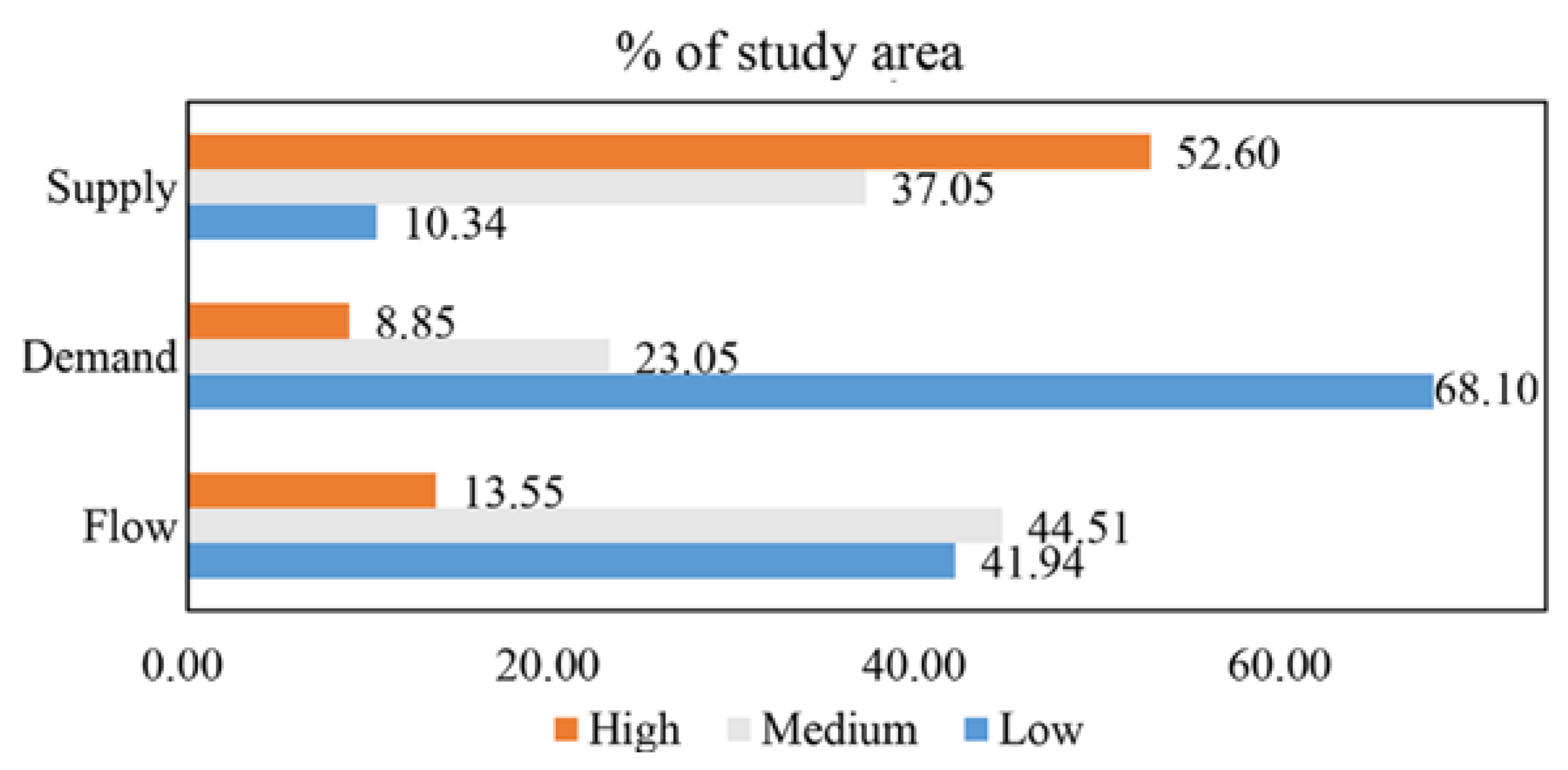

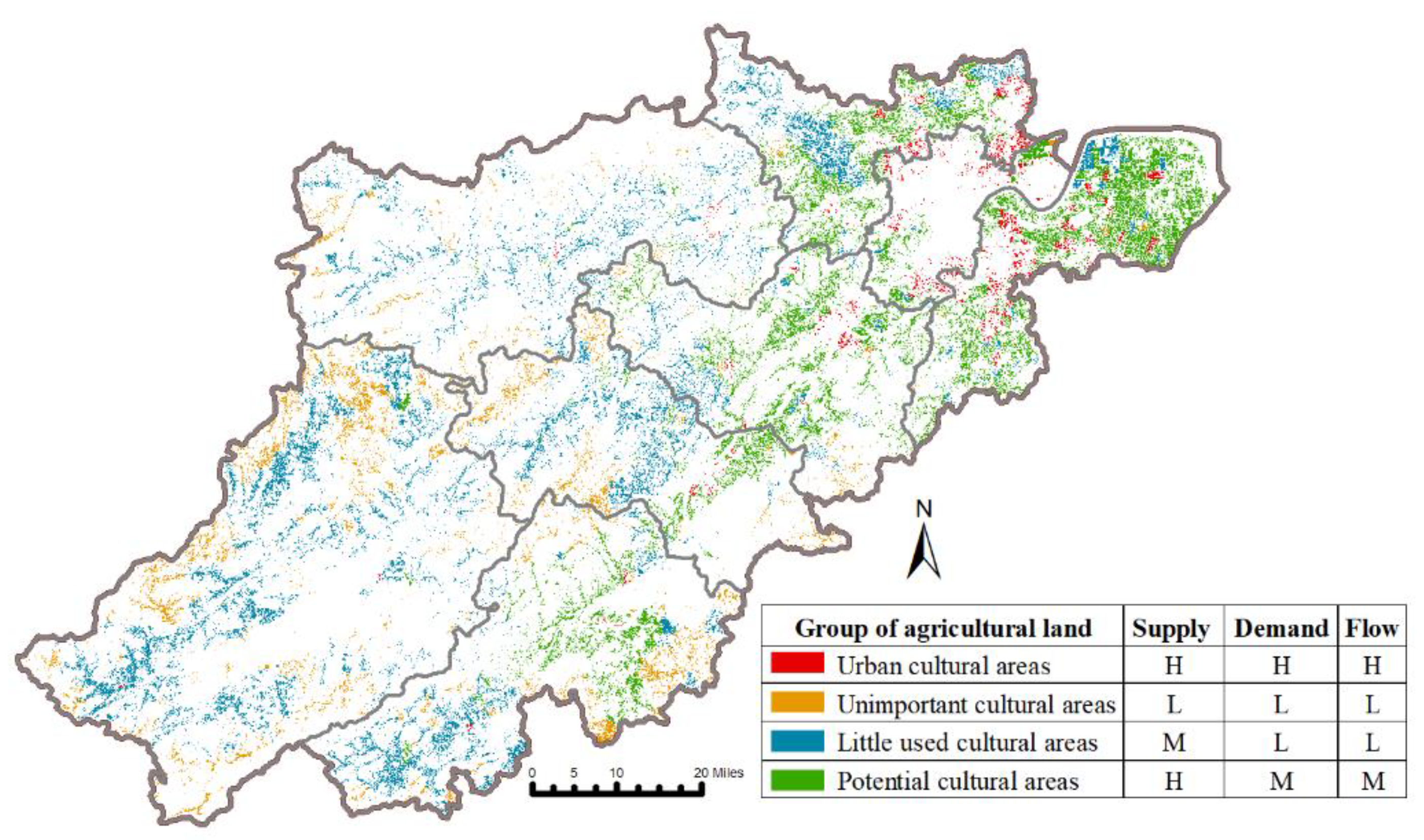
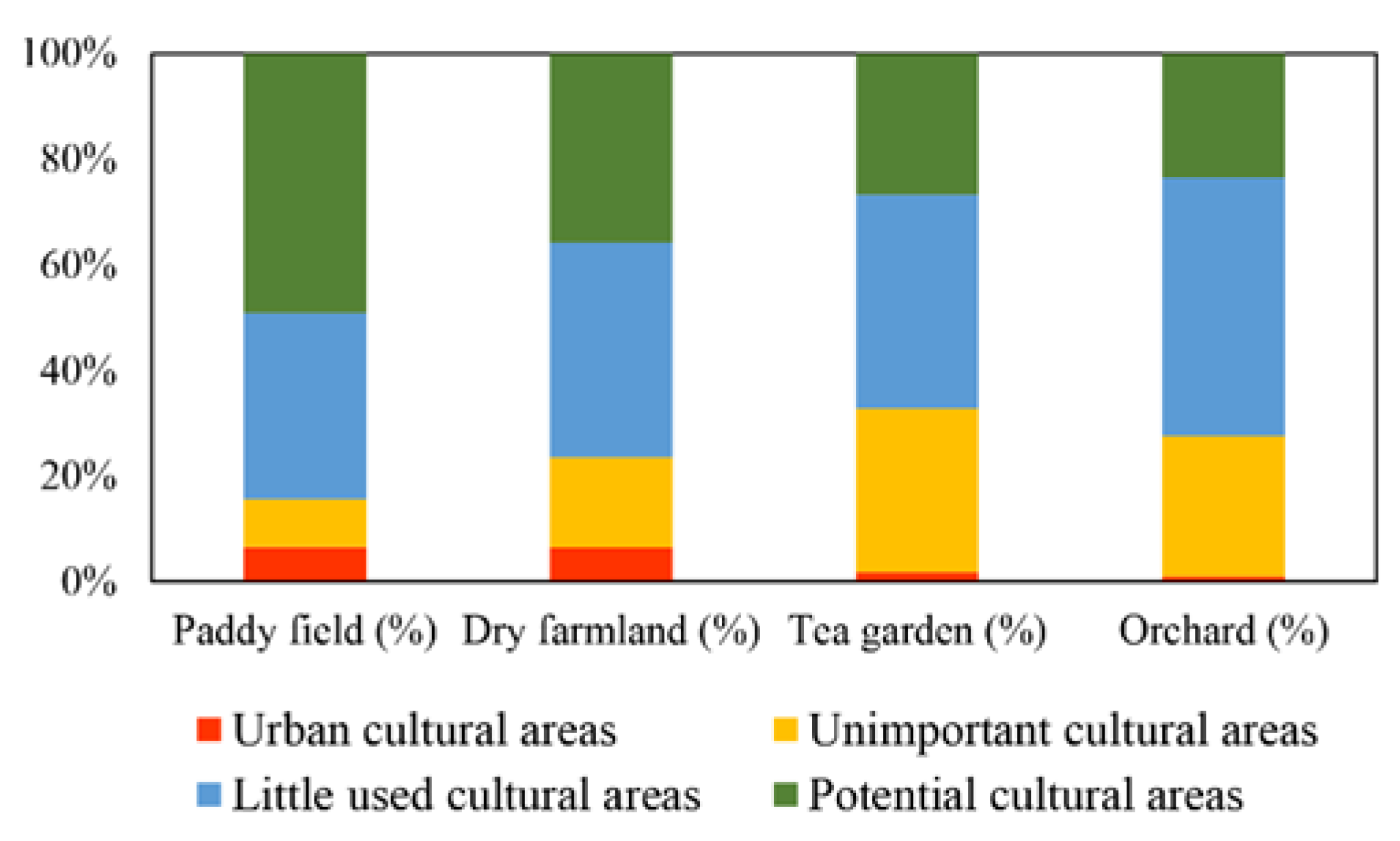
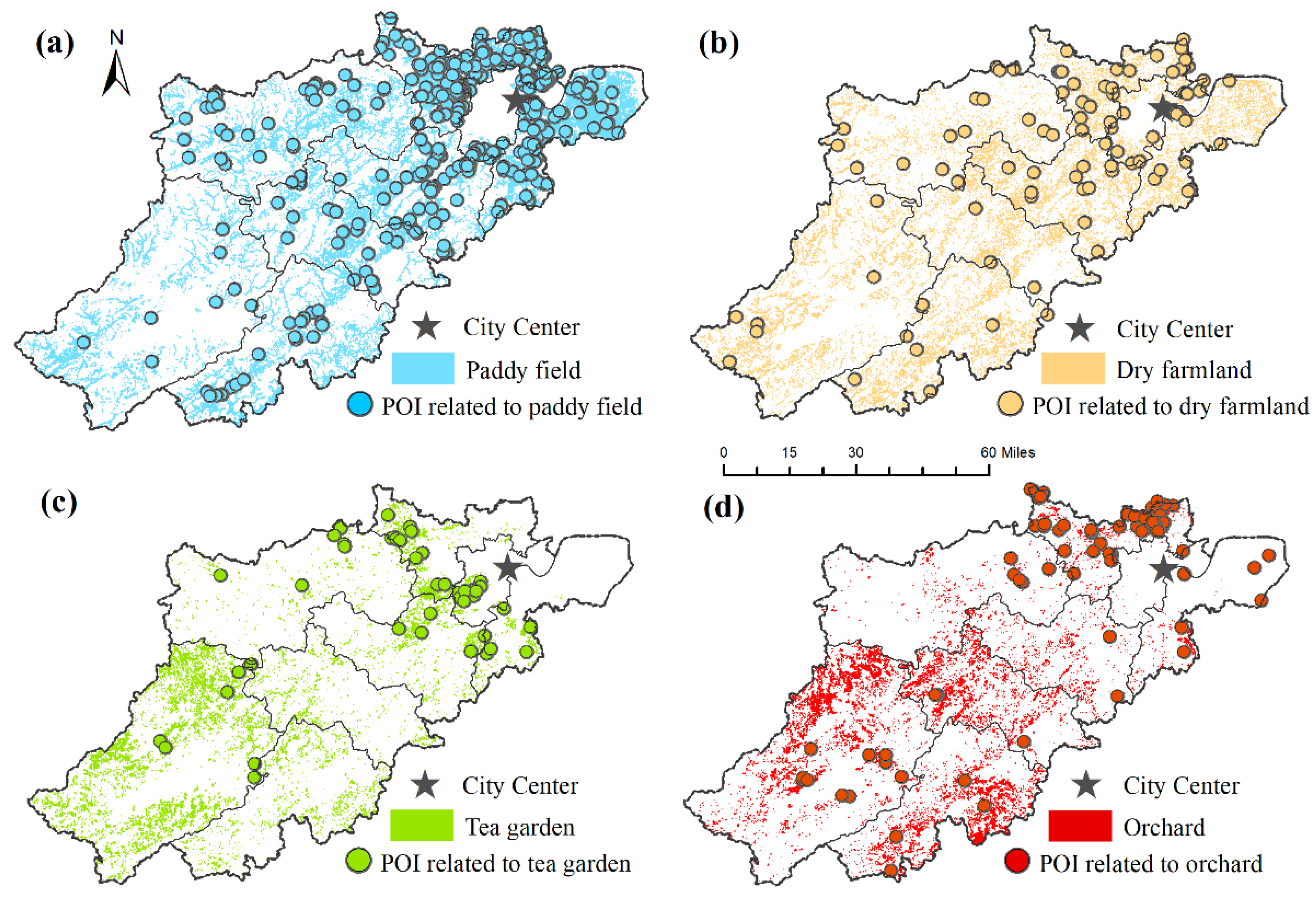
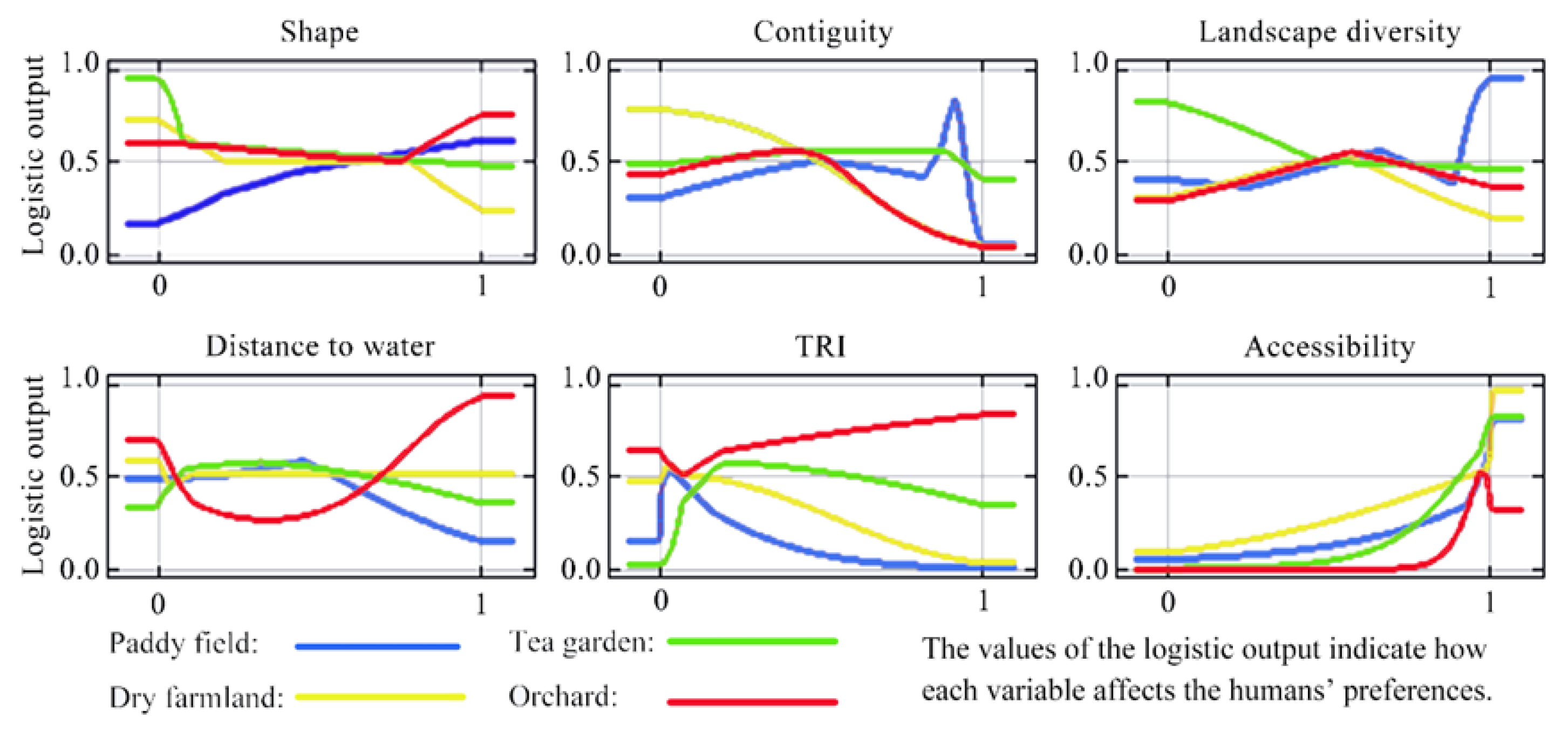
| Data | Type | Resolution | Source |
|---|---|---|---|
| Agricultural POI | Shapefile | 750 points | Open platform of Dainping.com website |
| Land use survey data a | Shapefile | 1:10,000 | Land and Resources Bureau of Hangzhou |
| Road network | Shapefile | 1:10,000 | Open street map [21] |
| Digital elevation model | Geo Tiff | 30 m | Geospatial data cloud [22] |
| Agritourists | Geo Tiff | County | Hangzhou Statistical Yearbooks [10] |
| Residents | Geo Tiff | 100 m | WorldPop project [23] |
| Indicator | Connotation | Method |
|---|---|---|
| Shape | Complexity of shapes of agricultural land patches | Calculated based on the perimeter and area of the agricultural land patches [25] |
| Contiguity | Degree of contiguity of agricultural land patches | |
| Landscape diversity | Landscape diversity index | Number of land use types per km2 [18] |
| Distance to water (m) | Distance to the nearest water bodies | Euclidean distance [2] |
| TRI | Terrain Ruggedness Index | TRI classes [1] |
| Accessibility | Travel time from residentials to agricultural land | Cost distance [1] |
| Types of Agricultural Land | Supply (%) | Demand (%) | Flow (%) | ||||||
|---|---|---|---|---|---|---|---|---|---|
| H | M | L | H | M | L | H | M | L | |
| Paddy field | 64.85 | 30.98 | 4.17 | 5.82 | 14.91 | 79.27 | 17.97 | 49.07 | 32.96 |
| Dry farmland | 42.57 | 43.49 | 13.93 | 6.53 | 10.13 | 83.33 | 12.45 | 43.61 | 43.95 |
| Tea garden | 37.95 | 39.62 | 22.42 | 5.29 | 2.76 | 91.95 | 8.38 | 37.86 | 53.76 |
| Orchard | 37.20 | 45.07 | 17.74 | 5.17 | 3.11 | 91.71 | 3.64 | 40.38 | 55.97 |
| Variable | Contribution (%) | Importance (%) | ||||||
|---|---|---|---|---|---|---|---|---|
| Paddy Field | Dry Farmland | Tea Garden | Orchard | Paddy Field | Dry Farmland | Tea Garden | Orchard | |
| Shape | 12.5 | 3.1 | 21.5 | 1.3 | 12.1 | 4.1 | 2.2 | 1.9 |
| Contiguity | 5.5 | 62.2 | 0.5 | 21.1 | 8.3 | 54.5 | 0.3 | 16.5 |
| Landscape diversity | 5.5 | 7.0 | 7.0 | 2.9 | 8.7 | 7.6 | 13.9 | 2.9 |
| Distance to water | 1.1 | 6.9 | 9.1 | 34.3 | 1.2 | 8.8 | 10.2 | 21.2 |
| TRI | 23.9 | 4.4 | 43.5 | 2.1 | 30.5 | 12.4 | 51.4 | 4.6 |
| Accessibility | 51.6 | 16.6 | 18.4 | 38.3 | 39.2 | 12.6 | 22.0 | 53.0 |
Publisher’s Note: MDPI stays neutral with regard to jurisdictional claims in published maps and institutional affiliations. |
© 2022 by the authors. Licensee MDPI, Basel, Switzerland. This article is an open access article distributed under the terms and conditions of the Creative Commons Attribution (CC BY) license (https://creativecommons.org/licenses/by/4.0/).
Share and Cite
He, S.; Hu, C.; Li, J.; Wu, J.; Xu, Q.; Lin, L.; Zhu, C.; Li, Y.; Zhou, M.; Zhu, L. Revealing Spatial Patterns of Cultural Ecosystem Services in Four Agricultural Landscapes: A Case Study from Hangzhou, China. Int. J. Environ. Res. Public Health 2022, 19, 9269. https://doi.org/10.3390/ijerph19159269
He S, Hu C, Li J, Wu J, Xu Q, Lin L, Zhu C, Li Y, Zhou M, Zhu L. Revealing Spatial Patterns of Cultural Ecosystem Services in Four Agricultural Landscapes: A Case Study from Hangzhou, China. International Journal of Environmental Research and Public Health. 2022; 19(15):9269. https://doi.org/10.3390/ijerph19159269
Chicago/Turabian StyleHe, Shan, Chenxia Hu, Jianfeng Li, Jieyi Wu, Qian Xu, Lin Lin, Congmou Zhu, Yongjun Li, Mengmeng Zhou, and Luyao Zhu. 2022. "Revealing Spatial Patterns of Cultural Ecosystem Services in Four Agricultural Landscapes: A Case Study from Hangzhou, China" International Journal of Environmental Research and Public Health 19, no. 15: 9269. https://doi.org/10.3390/ijerph19159269
APA StyleHe, S., Hu, C., Li, J., Wu, J., Xu, Q., Lin, L., Zhu, C., Li, Y., Zhou, M., & Zhu, L. (2022). Revealing Spatial Patterns of Cultural Ecosystem Services in Four Agricultural Landscapes: A Case Study from Hangzhou, China. International Journal of Environmental Research and Public Health, 19(15), 9269. https://doi.org/10.3390/ijerph19159269






